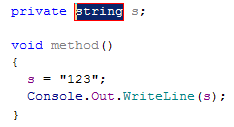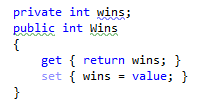Examples of Quick-Fixes
Quick-fixes are available in a variety of circumstances, which is too large to be listed. Rider provides a total of more than 1200 quick-fixes in all supported languages. Here we will show how to use them using a small selection of situations:
Type Mismatch
Whenever the type of an expression cannot be implicitly cast to the type applicable to the expression context, Rider detects this error and highlights it in the editor. After positioning the caret at the highlighted error and pressing Alt+Enter, the user can choose a quick-fix from the following list:
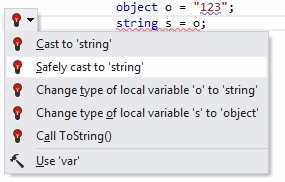
The effects of applying the proposed quick-fixes are illustrated in the table below.
| Quick-fix | Effect |
|---|---|
Cast to 'string' | |
Safely cast to 'string' | |
Change type of 'o' to 'string' | |
Change type of 's' to 'object' | |
Call ToString() | |
Undefined Variable
Whenever Rider detects an undefined variable in your code, the error is highlighted. After positioning the caret at the highlighted error and pressing Alt+Enter you will be presented with the following list of quick-fixes: 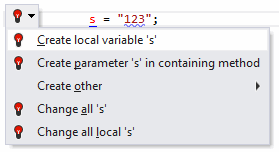
The effects of applying the proposed quick-fixes are illustrated in the table below.
Undefined Method Call
Whenever Rider detects a call to an undefined method in your code, the error gets highlighted. After positioning the caret at the highlighted error and pressing Alt+Enter, Rider displays the following list of quick-fixes:
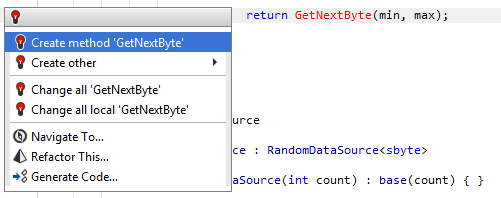
After applying a quick-fix, the code gets modified as shown in the following table:
| Quick-fix | Effect |
|---|---|
Create method 'ResolveManagedReference' | This quick-fix declares a new method with the signature derived from the method call, benefiting developers who prefer top-down programming. In our example, Rider creates the following declaration, correctly guessing the return type:  Rider also suggests applicable types and a name for the parameter of the new method:  |
| Create other | This sub-menu includes other quick-fixes involving creation of auxiliary code. For example: Create parameter ' or: Create parameter ' |
Change all 'ResolveManagedReference' | Similarly to the corresponding quick-fix for undefined variables, this quick-fix allows the user to quickly replace all occurrences of the symbol someMethod. |
Forgotten Method Return
If a method is expected to return a value but you forgot to provide a return statement, Rider warns you about that by highlighting the closing bracket of the troublesome method. After positioning the caret at the highlighted error and pressing Alt+Enter you will be presented with the following quick-fix:
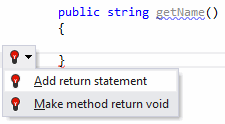
Missing Using Directives
Whenever you have a type name in your code that cannot be resolved because you forgot to write a corresponding using directive in your file, a small pop-up window suggests to import the type:

Press Alt+Enter, and the appropriate using directive will be inserted. Should there be multiple types with the matching name, you will be asked to choose the one you wish to use (see Importing Namespaces for details).
If for some reason you chose not to import a required namespace when the pop-up window was displayed, or if you cleared the Show the "Import namespace" action using popup check box on the page of Rider options, you can import a type at any time by putting the caret at the non-imported type, pressing Alt+Enter after a quick-fix shows up, and selecting the Import type [name] quick-fix:

Missing async modifier
If you have a method that contains the await operator, but that is not defined as asynchronous, Rider detects such mismatch and offers to fix this problem using the corresponding quick-fix.
Converting a loop to a LINQ expression
With C# 3.0 and LINQ, developers are able to write data-intensive code more easily by directly describing their intent to the compiler. Rider detects code that can be rewritten using LINQ syntax and offers to perform the conversion automatically:
Migrating to IEnumerable in method parameters and returns
Rider scans your code base to detect methods that can safely return and accept IEnumerable instead of a more specific type such as Array, List, or ArrayList:
Converting assignment statements to object initializers
Rider provides both a context action and a quick-fix to convert assignment statements into object initializers. The context action lets you add field assignments to an initializer one-by-one, whereas the quick-fix adds them all in one go. Here's how the quick-fix works:
Converting static method invocation to extension method call
When you invoke an extension method as a traditional C# static method, Rider helps you quickly comply with standard extension method call practices:
Converting anonymous method to lambda expression
Rider suggests converting anonymous methods to lambda expressions. The reverse functionality is provided as a context action.
Converting to auto-property
Rider makes it quick to convert traditional, private field-based properties to automatic properties implemented in C# 3.0. For more information, see Using Auto-Properties.
Making type parameter invariant
When a usage of a type parameter violates its variance, Rider suggests to make the parameter invariant:
| Before: |  |
| Applying the quick-fix: |  |
| After: |  |






